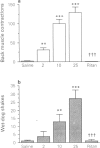Abstract
1. The behavioural effects of the intrathecal injection of a thyrotrophin-releasing hormone (TRH) analogue L-orotyl-L-histidyl-prolineamide (CG 3509, 0.5 micrograms), the non-selective 5-HT1 and 5-HT2 receptor agonist 5-methoxy-N,N'-dimethyltryptamine (5-MeODMT, 2-100 micrograms) and the selective 5-HT2 receptor agonist 2,5-dimethoxy-alpha,4-dimethyl-benzene ethamine hydrochloride (DOM, 2-25 micrograms) were compared with the response of systemically administered 5-MeODMT (2 mg kg-1, i.p.) in rats, to establish whether the agonist-induced behaviours were mediated by bulbospinal 5-HT1 or 5-HT2 receptors. 2. Intrathecal injection of 5-MeODMT or DOM produced dose-related back muscle contractions (a previously undocumented behaviour) and wet-dog shakes which were both markedly attenuated by ritanserin pretreatment (1 mg kg-1, i.p.) indicating the involvement of 5-HT2 receptors. In contrast, reciprocal forepaw treading, flat body posture and Straub-tail were evoked by 5-MeODMT but not by DOM indicating that these behaviours were not produced by 5-HT2 receptor activation alone. However, as ritanserin pretreatment reduced the reciprocal forepaw treading induced by intrathecal 5-MeODMT, this behaviour may be facilitated by 5-HT2 receptor activation. 3. Intrathecal 5,7-dihydroxytryptamine (5,7-DHT, 2 x 150 micrograms) treatment decreased thoraco-lumbar spinal cord 5-HT (-95%) and potentiated the back muscle contractions produced by intrathecal DOM injection without altering the wet-dog shake behaviour. None of the components of the 5-HT syndrome produced by 5-MeODMT (2 mg kg-1, i.p.), with the exception of a small increase in wet-dog shakes, was significantly altered by intrathecal 5,7-DHT (which reduced thoraco-lumbar spinal cord 5-HT by 84%). Taken together these data suggest that the only 5-HT agonist-induced behaviour mediated by the activation of 5-HT2 receptors located postsynaptic to bulbospinal 5-hydroxytryptaminergic (5-HTergic) neurones was back muscle contractions. 4. The wet-dog shake and forepaw licking behaviors produced by intrathecal CG 3509 (0.5 micrograms) were attenuated when ritanserin was administered intrathecally 30 min before, but not when it was given at the same time as CG 3509 and neither behaviour was altered by intrathecal 5,7-DHT. This suggests that bulbospinal 5-HTergic neurones are not involved in the production of these TRH analogue-induced behaviours and that the 5-HT2 receptors which mediate these behaviours are not located in the spinal cord.
Full text
PDF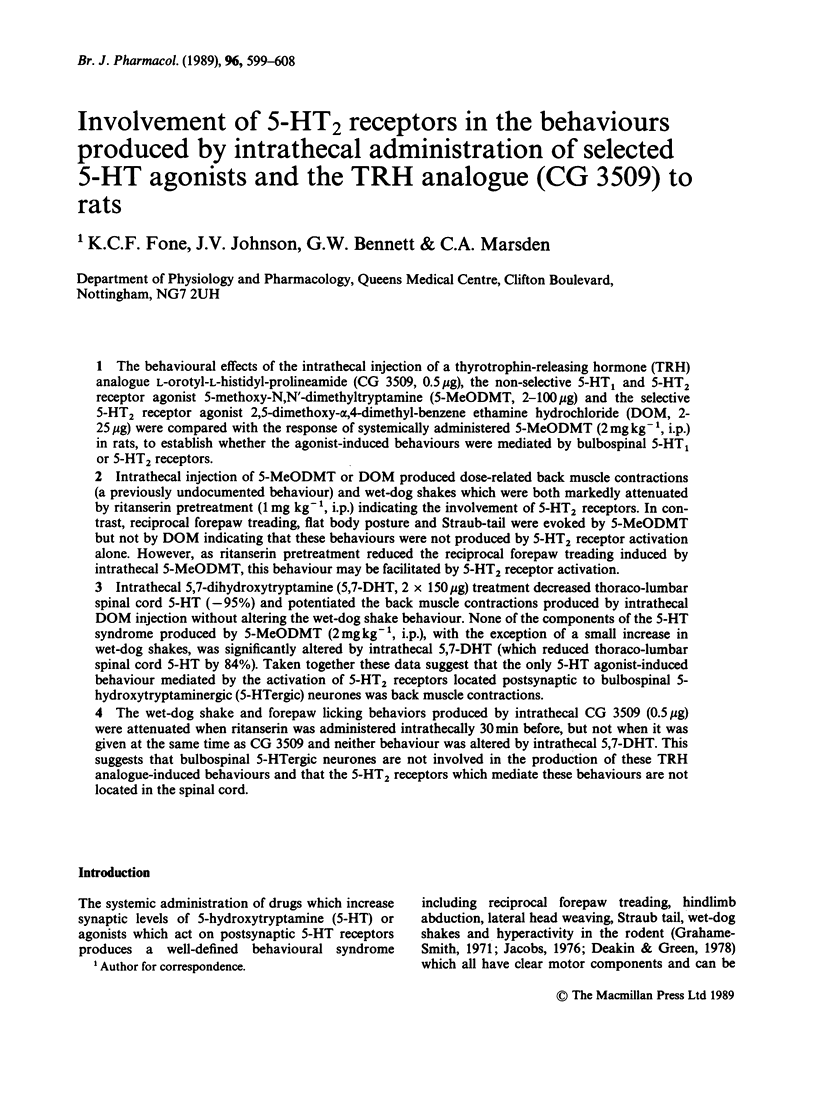
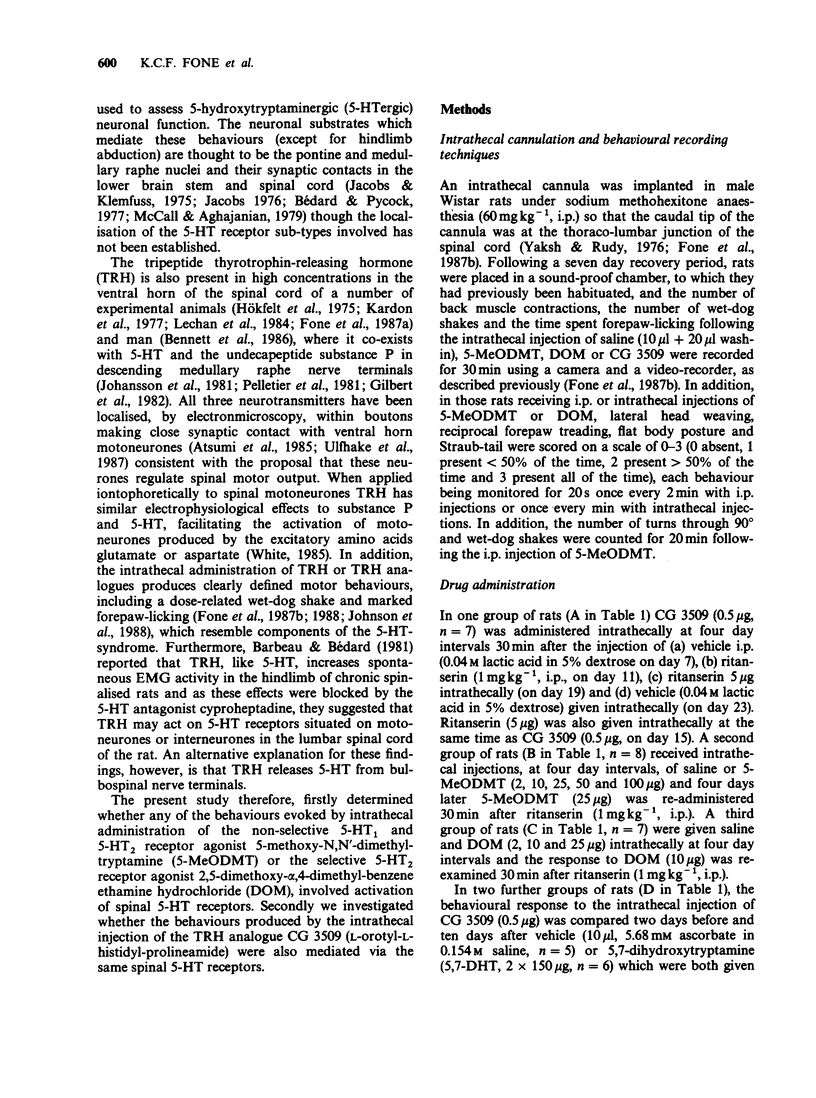
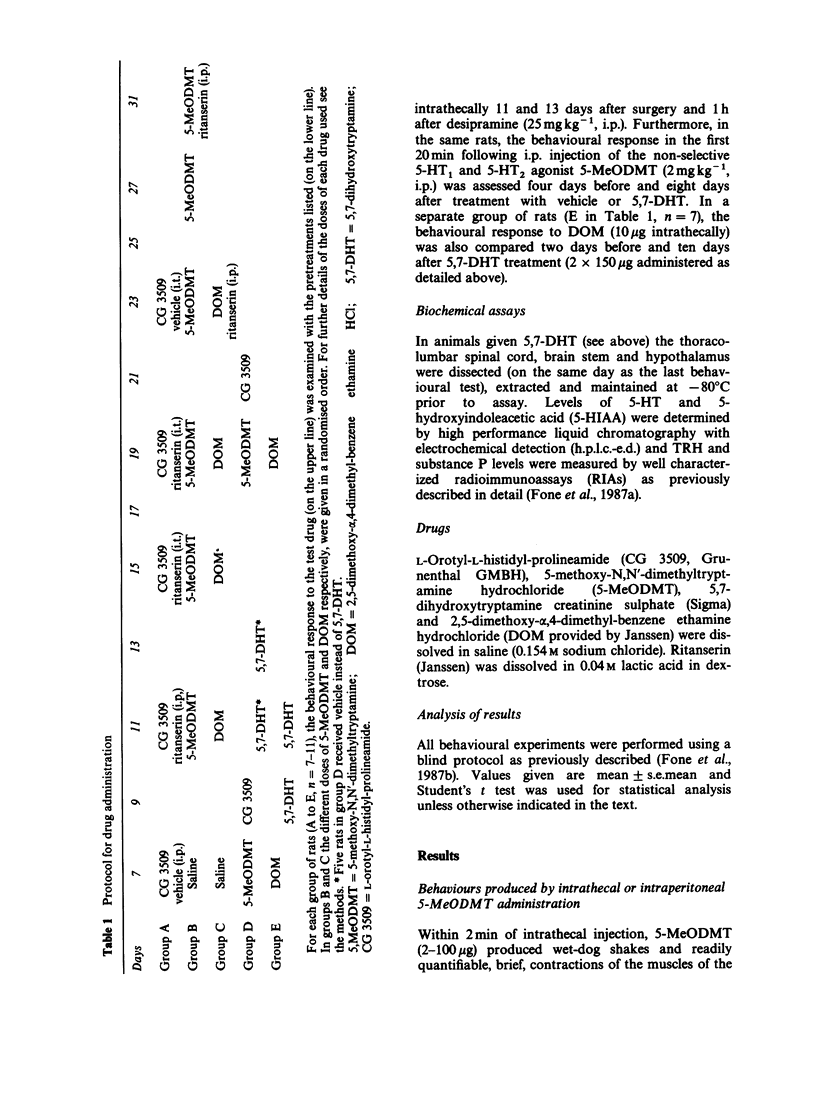
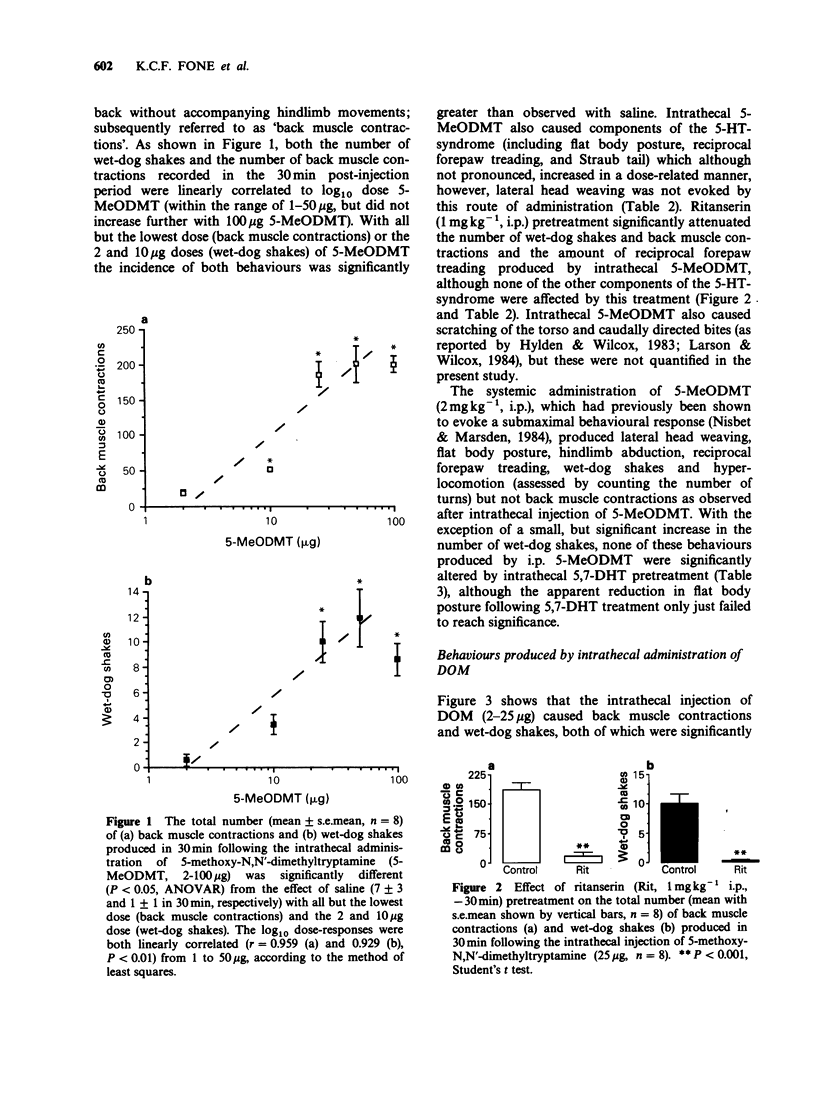
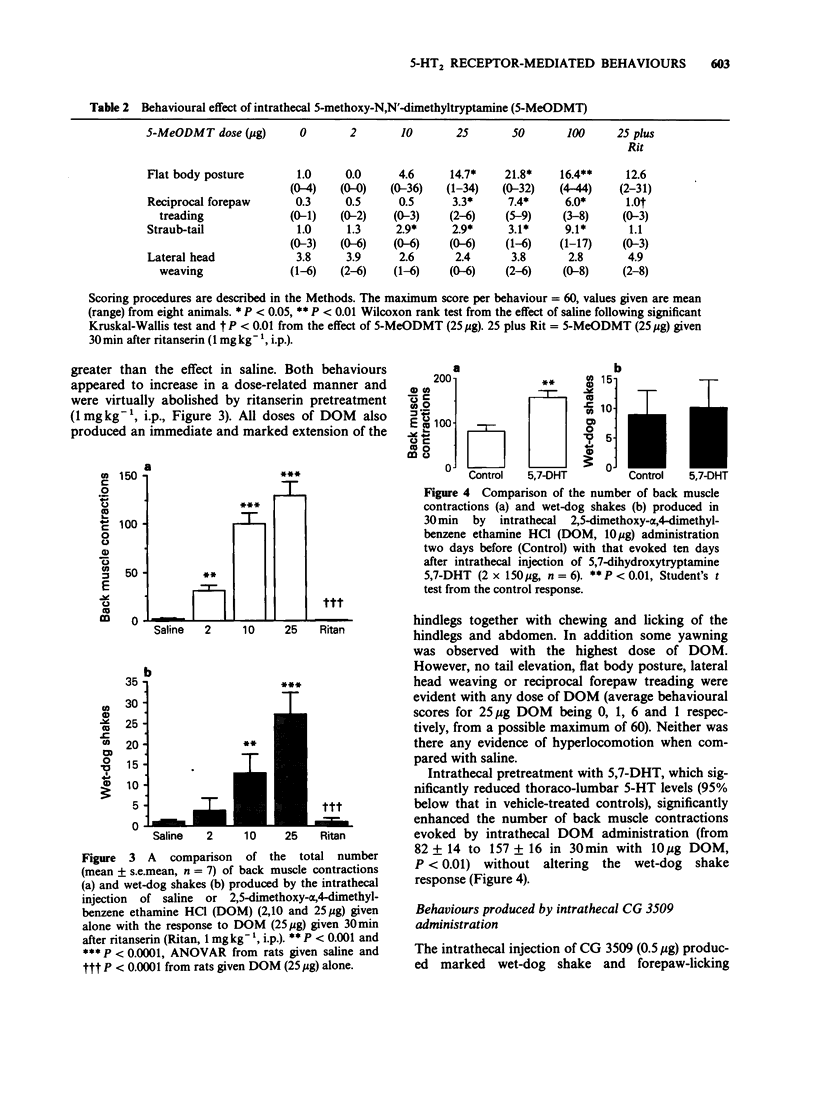
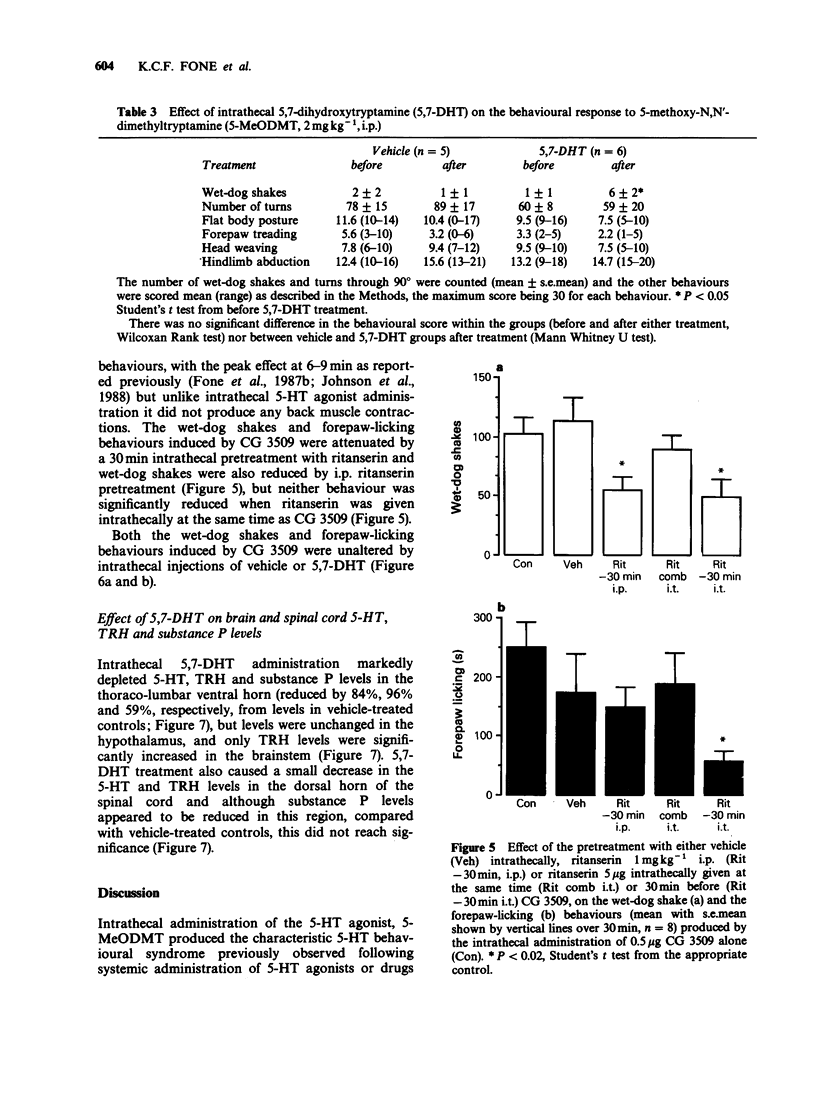
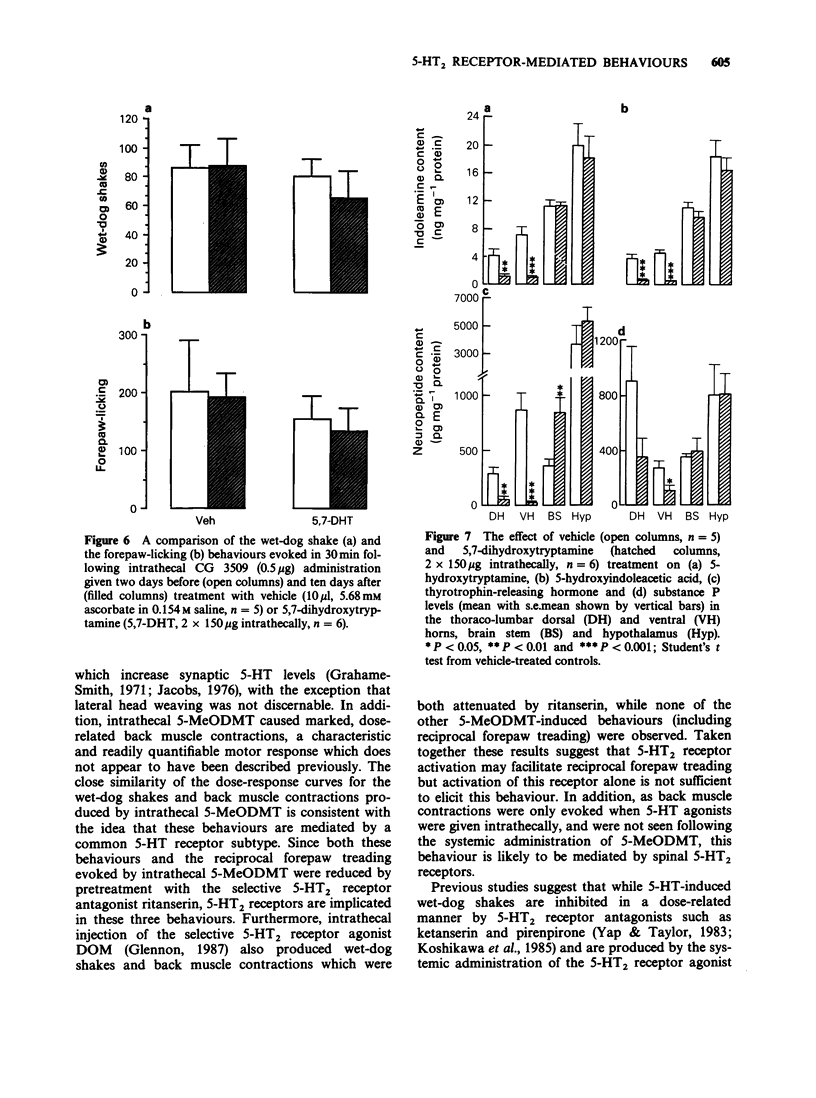
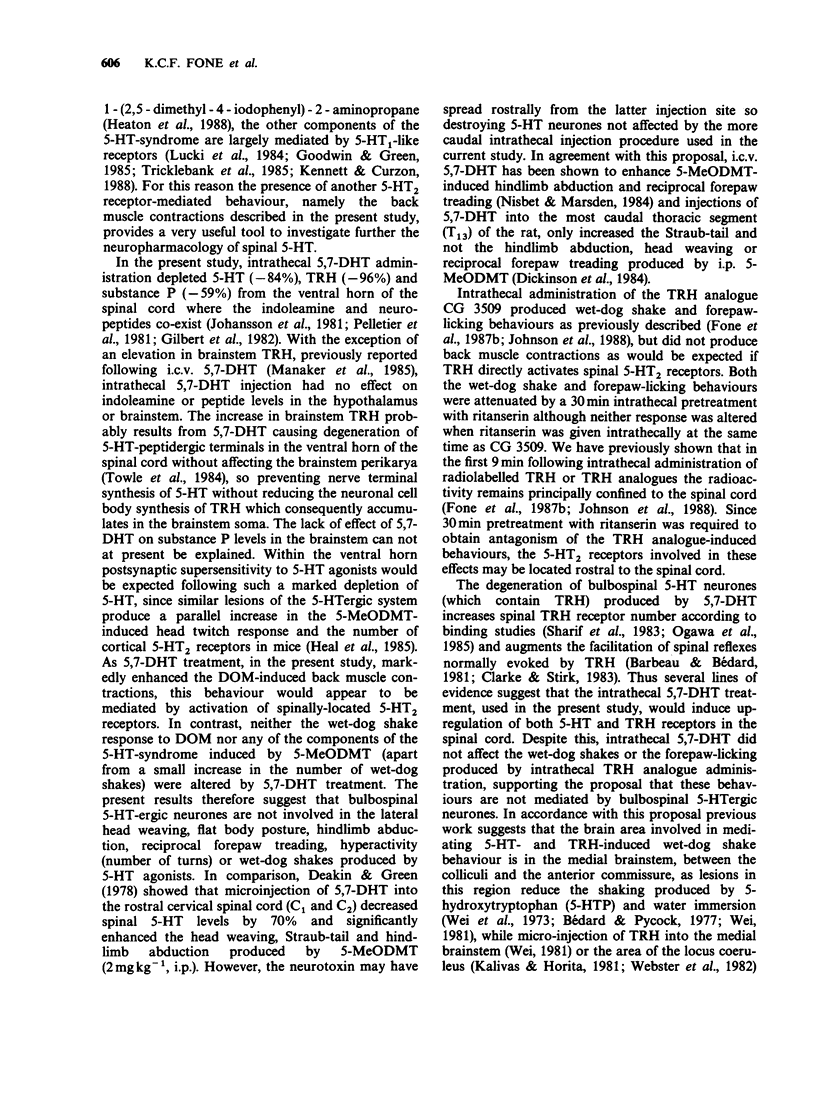
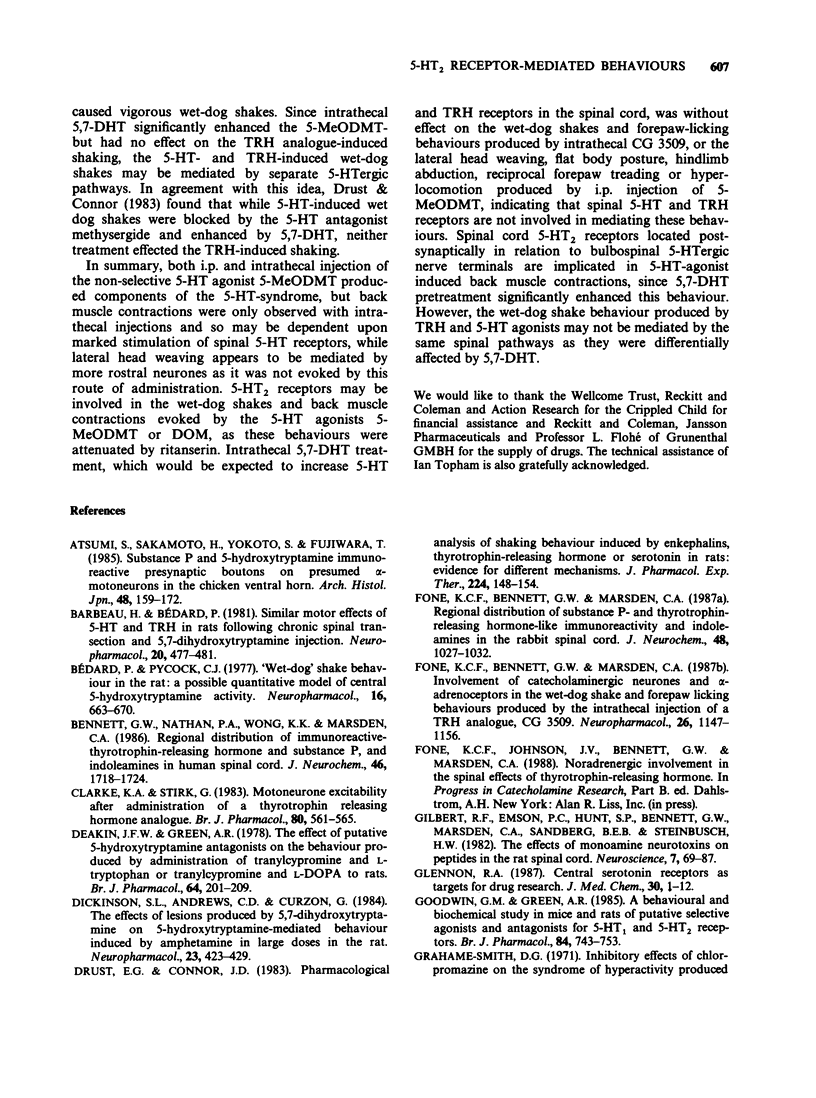
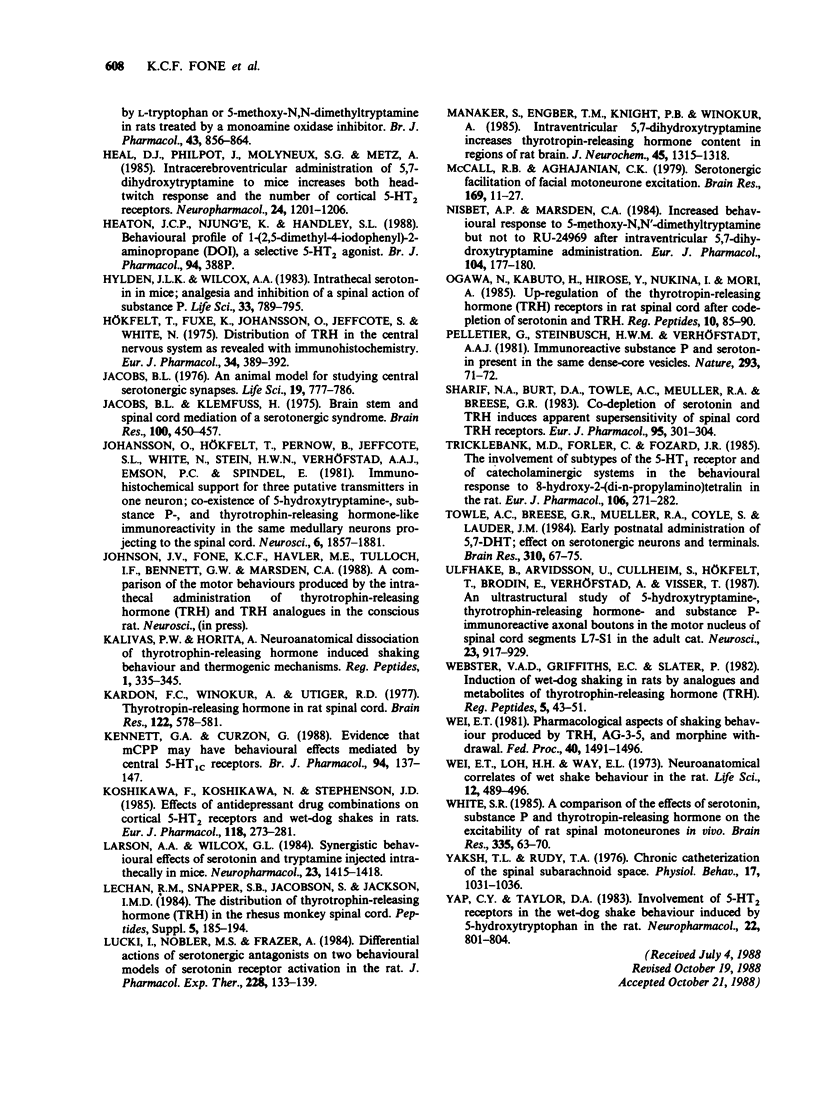
Images in this article
Selected References
These references are in PubMed. This may not be the complete list of references from this article.
- Atsumi S., Sakamoto H., Yokota S., Fujiwara T. Substance P and 5-hydroxytryptamine immunoreactive presynaptic boutons on presumed alpha-motoneurons in the chicken ventral horn. Arch Histol Jpn. 1985 Apr;48(2):159–172. doi: 10.1679/aohc.48.159. [DOI] [PubMed] [Google Scholar]
- Barbeau H., Bédard P. Similar motor effects of 5-HT and TRH in rats following chronic spinal transection and 5.7-dihydroxytryptamine injection. Neuropharmacology. 1981 May;20(5):477–481. doi: 10.1016/0028-3908(81)90181-7. [DOI] [PubMed] [Google Scholar]
- Bedard P., Pycock C. J. "Wet-dog" shake behaviour in the rat: a possible quantitative model of central 5-hydroxytryptamine activity. Neuropharmacology. 1977 Oct;16(10):663–670. doi: 10.1016/0028-3908(77)90117-4. [DOI] [PubMed] [Google Scholar]
- Bennett G. W., Nathan P. A., Wong K. K., Marsden C. A. Regional distribution of immunoreactive-thyrotrophin-releasing hormone and substance P, and indoleamines in human spinal cord. J Neurochem. 1986 Jun;46(6):1718–1724. doi: 10.1111/j.1471-4159.1986.tb08489.x. [DOI] [PubMed] [Google Scholar]
- Clarke K. A., Stirk G. Motoneurone excitability after administration of a thyrotrophin releasing hormone analogue. Br J Pharmacol. 1983 Nov;80(3):561–565. doi: 10.1111/j.1476-5381.1983.tb10729.x. [DOI] [PMC free article] [PubMed] [Google Scholar]
- Deakin J. F., Green A. R. The effects of putative 5-hydroxytryptamine antagonists on the behaviour produced by administration of tranylcypromine and L-tryptophan or tranylcypromine and L-DOPA to rats. Br J Pharmacol. 1978 Oct;64(2):201–209. doi: 10.1111/j.1476-5381.1978.tb17290.x. [DOI] [PMC free article] [PubMed] [Google Scholar]
- Dickinson S. L., Andrews C. D., Curzon G. The effects of lesions produced by 5,7-dihydroxytryptamine on 5-hydroxytryptamine-mediated behaviour induced by amphetamine in large doses in the rat. Neuropharmacology. 1984 Apr;23(4):423–429. doi: 10.1016/0028-3908(84)90250-8. [DOI] [PubMed] [Google Scholar]
- Drust E. G., Connor J. D. Pharmacological analysis of shaking behavior induced by enkephalins, thyrotropin-releasing hormone or serotonin in rats: evidence for different mechanisms. J Pharmacol Exp Ther. 1983 Jan;224(1):148–154. [PubMed] [Google Scholar]
- Fone K. C., Bennett G. W., Marsden C. A. Involvement of catecholaminergic neurones and alpha-adrenoceptors in the wet-dog shake and forepaw licking behaviour produced by the intrathecal injection of an analogue of thyrotrophin-releasing hormone (CG 3509). Neuropharmacology. 1987 Aug;26(8):1147–1155. doi: 10.1016/0028-3908(87)90261-9. [DOI] [PubMed] [Google Scholar]
- Fone K. C., Bennett G. W., Marsden C. A. Regional distribution of substance P- and thyrotrophin-releasing hormone-like immunoreactivity and indoleamines in the rabbit spinal cord. J Neurochem. 1987 Apr;48(4):1027–1032. doi: 10.1111/j.1471-4159.1987.tb05621.x. [DOI] [PubMed] [Google Scholar]
- Gilbert R. F., Emson P. C., Hunt S. P., Bennett G. W., Marsden C. A., Sandberg B. E., Steinbusch H. W., Verhofstad A. A. The effects of monoamine neurotoxins on peptides in the rat spinal cord. Neuroscience. 1982 Jan;7(1):69–87. doi: 10.1016/0306-4522(82)90154-3. [DOI] [PubMed] [Google Scholar]
- Glennon R. A. Central serotonin receptors as targets for drug research. J Med Chem. 1987 Jan;30(1):1–12. doi: 10.1021/jm00384a001. [DOI] [PubMed] [Google Scholar]
- Goodwin G. M., Green A. R. A behavioural and biochemical study in mice and rats of putative selective agonists and antagonists for 5-HT1 and 5-HT2 receptors. Br J Pharmacol. 1985 Mar;84(3):743–753. doi: 10.1111/j.1476-5381.1985.tb16157.x. [DOI] [PMC free article] [PubMed] [Google Scholar]
- Grahame-Smith D. G. Inhibitory effect of chlorpromazine on the syndrome of hyperactivity produced by L-tryptophan or 5-methoxy-N,N-dimethyltryptamine in rats treated with a monoamine oxidase inhibitor. Br J Pharmacol. 1971 Dec;43(4):856–864. doi: 10.1111/j.1476-5381.1971.tb07222.x. [DOI] [PMC free article] [PubMed] [Google Scholar]
- Heal D. J., Philpot J., Molyneux S. G., Metz A. Intracerebroventricular administration of 5,7-dihydroxytryptamine to mice increases both head-twitch response and the number of cortical 5-HT2 receptors. Neuropharmacology. 1985 Dec;24(12):1201–1205. doi: 10.1016/0028-3908(85)90155-8. [DOI] [PubMed] [Google Scholar]
- Hylden J. L., Wilcox G. L. Intrathecal serotonin in mice: analgesia and inhibition of a spinal action of substance P. Life Sci. 1983 Aug 22;33(8):789–795. doi: 10.1016/0024-3205(83)90785-3. [DOI] [PubMed] [Google Scholar]
- Hökfelt T., Fuxe K., Johansson O., Jeffcoate S., White N. Distribution of thyrotropin-releasing hormone (TRH) in the central nervous system as revealed with immunohistochemistry. Eur J Pharmacol. 1975 Dec;34(2):389–392. doi: 10.1016/0014-2999(75)90269-1. [DOI] [PubMed] [Google Scholar]
- Jacobs B. L. An animal behavior model for studying central serotonergic synapses. Life Sci. 1976 Sep 15;19(6):777–785. doi: 10.1016/0024-3205(76)90303-9. [DOI] [PubMed] [Google Scholar]
- Jacobs B. L., Klemfuss H. Brain stem and spinal cord mediation of a serotonergic behavioral syndrome. Brain Res. 1975 Dec 19;100(2):450–457. doi: 10.1016/0006-8993(75)90500-4. [DOI] [PubMed] [Google Scholar]
- Johansson O., Hökfelt T., Pernow B., Jeffcoate S. L., White N., Steinbusch H. W., Verhofstad A. A., Emson P. C., Spindel E. Immunohistochemical support for three putative transmitters in one neuron: coexistence of 5-hydroxytryptamine, substance P- and thyrotropin releasing hormone-like immunoreactivity in medullary neurons projecting to the spinal cord. Neuroscience. 1981;6(10):1857–1881. doi: 10.1016/0306-4522(81)90028-2. [DOI] [PubMed] [Google Scholar]
- Kardon F. C., Winokur A., Utiger R. D. Thyrotropin-releasing hormone (TRH) in rat spinal cord. Brain Res. 1977 Feb 25;122(3):578–581. doi: 10.1016/0006-8993(77)90471-1. [DOI] [PubMed] [Google Scholar]
- Kennett G. A., Curzon G. Evidence that mCPP may have behavioural effects mediated by central 5-HT1C receptors. Br J Pharmacol. 1988 May;94(1):137–147. doi: 10.1111/j.1476-5381.1988.tb11508.x. [DOI] [PMC free article] [PubMed] [Google Scholar]
- Koshikawa F., Koshikawa N., Stephenson J. D. Effects of antidepressant drug combinations on cortical 5-HT2 receptors and wet-dog shakes in rats. Eur J Pharmacol. 1985 Dec 3;118(3):273–281. doi: 10.1016/0014-2999(85)90138-4. [DOI] [PubMed] [Google Scholar]
- Larson A. A., Wilcox G. L. Synergistic behavioral effects of serotonin and tryptamine injected intrathecally in mice. Neuropharmacology. 1984 Dec;23(12A):1415–1418. doi: 10.1016/0028-3908(84)90082-0. [DOI] [PubMed] [Google Scholar]
- Lechan R. M., Snapper S. B., Jacobson S., Jackson I. M. The distribution of thyrotropin-releasing hormone (TRH) in the rhesus monkey spinal cord. Peptides. 1984;5 (Suppl 1):185–194. doi: 10.1016/0196-9781(84)90276-6. [DOI] [PubMed] [Google Scholar]
- Lucki I., Nobler M. S., Frazer A. Differential actions of serotonin antagonists on two behavioral models of serotonin receptor activation in the rat. J Pharmacol Exp Ther. 1984 Jan;228(1):133–139. [PubMed] [Google Scholar]
- Manaker S., Engber T. M., Knight P. B., Winokur A. Intraventricular 5,7-dihydroxytryptamine increases thyrotropin-releasing hormone content in regions of rat brain. J Neurochem. 1985 Oct;45(4):1315–1318. doi: 10.1111/j.1471-4159.1985.tb05561.x. [DOI] [PubMed] [Google Scholar]
- McCall R. B., Aghajanian G. K. Serotonergic facilitation of facial motoneuron excitation. Brain Res. 1979 Jun 15;169(1):11–27. doi: 10.1016/0006-8993(79)90370-6. [DOI] [PubMed] [Google Scholar]
- Nisbet A. P., Marsden C. A. Increased behavioural response to 5-methoxy-N,N-dimethyltryptamine but not to RU-24969 after intraventricular 5,7-dihydroxytryptamine administration. Eur J Pharmacol. 1984 Sep 3;104(1-2):177–180. doi: 10.1016/0014-2999(84)90387-x. [DOI] [PubMed] [Google Scholar]
- Ogawa N., Kabuto H., Hirose Y., Nukina I., Mori A. Up-regulation of thyrotropin-releasing hormone (TRH) receptors in rat spinal cord after codepletion of serotonin and TRH. Regul Pept. 1985 Mar;10(2-3):85–90. doi: 10.1016/0167-0115(85)90002-3. [DOI] [PubMed] [Google Scholar]
- Pelletier G., Steinbusch H. W., Verhofstad A. A. Immunoreactive substance P and serotonin present in the same dense-core vesicles. Nature. 1981 Sep 3;293(5827):71–72. doi: 10.1038/293071a0. [DOI] [PubMed] [Google Scholar]
- Sharif N. A., Burt D. R., Towle A. C., Mueller R. A., Breese G. R. Codepletion of serotonin and TRH induces apparent supersensitivity of spinal TRH receptors. Eur J Pharmacol. 1983 Nov 25;95(3-4):301–304. doi: 10.1016/0014-2999(83)90651-9. [DOI] [PubMed] [Google Scholar]
- Towle A. C., Breese G. R., Mueller R. A., Coyle S., Lauder J. M. Early postnatal administration of 5,7-DHT: effects on serotonergic neurons and terminals. Brain Res. 1984 Sep 17;310(1):67–75. doi: 10.1016/0006-8993(84)90010-6. [DOI] [PubMed] [Google Scholar]
- Tricklebank M. D., Forler C., Fozard J. R. The involvement of subtypes of the 5-HT1 receptor and of catecholaminergic systems in the behavioural response to 8-hydroxy-2-(di-n-propylamino)tetralin in the rat. Eur J Pharmacol. 1984 Nov 13;106(2):271–282. doi: 10.1016/0014-2999(84)90714-3. [DOI] [PubMed] [Google Scholar]
- Ulfhake B., Arvidsson U., Cullheim S., Hökfelt T., Brodin E., Verhofstad A., Visser T. An ultrastructural study of 5-hydroxytryptamine-, thyrotropin-releasing hormone- and substance P-immunoreactive axonal boutons in the motor nucleus of spinal cord segments L7-S1 in the adult cat. Neuroscience. 1987 Dec;23(3):917–929. doi: 10.1016/0306-4522(87)90168-0. [DOI] [PubMed] [Google Scholar]
- Webster V. A., Griffiths E. C., Slater P. Induction of wet-dog shaking in rats by analogues and metabolites of thyrotrophin-releasing hormone (TRH). Regul Pept. 1982 Dec;5(1):43–51. doi: 10.1016/0167-0115(82)90074-x. [DOI] [PubMed] [Google Scholar]
- Wei E. T. Pharmacological aspects of shaking behavior produced by TRH, AG-3-5, and morphine withdrawal. Fed Proc. 1981 Apr;40(5):1491–1496. [PubMed] [Google Scholar]
- Wei E., Loh H. H., Way E. L. Neuroanatomical correlates of wet shake behavior in the rat. Life Sci II. 1973 Jun 8;12(4):489–496. doi: 10.1016/0024-3205(73)90342-1. [DOI] [PubMed] [Google Scholar]
- White S. R. A comparison of the effects of serotonin, substance P and thyrotropin-releasing hormone on excitability of rat spinal motoneurons in vivo. Brain Res. 1985 May 27;335(1):63–70. doi: 10.1016/0006-8993(85)90276-8. [DOI] [PubMed] [Google Scholar]
- Yaksh T. L., Rudy T. A. Chronic catheterization of the spinal subarachnoid space. Physiol Behav. 1976 Dec;17(6):1031–1036. doi: 10.1016/0031-9384(76)90029-9. [DOI] [PubMed] [Google Scholar]
- Yap C. Y., Taylor D. A. Involvement of 5-HT2 receptors in the wet-dog shake behaviour induced by 5-hydroxytryptophan in the rat. Neuropharmacology. 1983 Jul;22(7):801–804. doi: 10.1016/0028-3908(83)90123-5. [DOI] [PubMed] [Google Scholar]




